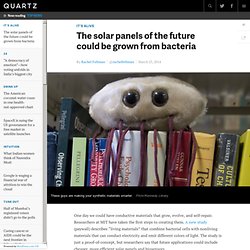

Solar energy prospects are bright for Scotland, experts say. PowerjapanPlus. Power Japan Plus Reveals New Ryden Dual Carbon Battery New battery design balances the need for cost competitive energy storage that is energy dense, reliable, safe and sustainable SAN FRANCISCO, Calif. — May 13, 2014 — Power Japan Plus today launched a new battery technology – the Ryden dual carbon battery.

This unique battery offers energy density comparable to a lithium ion battery, but over a much longer functional lifetime with drastically improved safety and cradle-to-cradle sustainability. Top 7 Reasons To Go For An Electric Vehicle. Cars Published on April 9th, 2014 | by Guest Contributor Originally published on the website of the Union of Concerned Scientists.By Josh Goldman You may have heard a lot recently about electric vehicles (EVs).

Sales of EVs are up, manufacturers are beginning to offer a variety of EV models – from sportscars to sedans – and our recent analysis found that 42 percent of American households with a vehicle could use an EV. So, why are car buyers getting more enthused about EVs? #1 Cheaper to Fuel Like saving money? “I have owned a Nissan Leaf for 2 years. . #2 Less Volatile Fuel Prices. Western Australia wave energy project on the brink of commercialisation. Australia could be set for a breakthrough in energy derived from waves, following the launch a major new project in Western Australia.

Carnegie Wave Energy unveiled three large buoys in Perth on Wednesday as part of a new $70 million technology which will feed energy into the Australian grid later this year. The solar panels of the future could be grown from bacteria. One day we could have conductive materials that grow, evolve, and self-repair.

Researchers at MIT have taken the first steps to creating them. A new study (paywall) describes “living materials” that combine bacterial cells with nonliving materials that can conduct electricity and emit different colors of light. The study is just a proof-of-concept, but researchers say that future applications could include cheaper, more efficient solar panels and biosensors. “When you look around the natural world,” lead author Timothy Lu told Quartz, “you can see that biology has done a great job of designing unique materials.
But in our day-to-day lives, we use materials that aren’t alive in any way.” Cheap batteries will revolutionise the renewable energy market. News this week, from opposite ends of the planet, that points to the convulsion of change about to hit the global economy. The first report came from Palo Alto, California, headquarters of the Tesla electric car company. Tesla's car produces no carbon emissions (so long as the electricity that charges its batteries is also low carbon). Tesla's chief executive, Elon Musk, announced it would invest in a $4bn-$5bn "gigafactory" doubling the world's production of lithium-ion batteries. These power your mobile phone, but also Tesla's high-end luxury electric cars. The objective is to cut battery prices by 30% in three years, and to halve them by 2020.
Desert plants fed with saltwater produce amazing new biofuel for Boeing and Etihad. In 2012, the world’s airlines transported three billion people, emitting 689 million tonnes of CO2 into the atmosphere.

To mitigate the aviation industry’s future environmental impact, Boeing, Etihad Airways and the Masdar Institute of Technology are working on a groundbreaking new jet fuel made from desert plants fed with saltwater. While the aviation industry only contributed two per cent of the world’s total CO2 emissions, its environmental impact is significant enough, and fossil fuels sufficiently infinite, that major airlines such as Boeing and Etihad are concerned to find new sources of clean energy. On January 18 the group announced that they have discovered that halophytes (plants that can grow in saline conditions) fed with nutrient rich wastewater produce an efficient biofuel. The leftover water from this can then be used to feed mangrove forests, where it is purified before returning to the Persian Gulf. (Related post: UN says aquaculture could solve fish collapse)
QUANT e-Sportlimousine with nanoFLOWCELL® drive. Tame hurricanes with offshore wind farms. Computer simulations show that offshore wind farms with thousands of turbines could have sapped the power of three real-life hurricanes, significantly decreasing their winds and accompanying storm surge, and possibly preventing billions of dollars in damages.

For the past 24 years, Mark Z. Jacobson, professor of civil and environmental engineering at Stanford University, has been developing a complex computer model to study air pollution, energy, weather, and climate. A recent application of the model has been to simulate the development of hurricanes. Another has been to determine how much energy wind turbines can extract from global wind currents. In light of these recent model studies and in the aftermath of hurricanes Sandy and Katrina, Jacobson says, it was natural to wonder: What would happen if a hurricane encountered a large array of offshore wind turbines? Biofuel crops 'may amplify mosquito-borne disease'
Combining OTEC with floating cities? During the Seasteading Conference in San Francisco, US in May 2012 new ideas were presented for advancing seasteading, or permanent dwellings on the ocean.

According to the Randolph Hencken, the Seasteading Institute director, “the ocean provides a space to innovate with political and social systems that could advance and serve humanity”. Amongst the speakers were Robert J. Nicholson, President of OTEC International, and ocean policy expert Patrick Takahashi, Director Emeritus of the Hawaii Natural Energy Institute at the University of Hawaii. They presented the possibilities for connecting the benefits of OTEC to floating seasteading cities in tropical oceans, supplying energy, fresh water, and enabling a new ocean ecosystem. Scotland Will Soon Be Home to the World's First Self-Sufficient Island. Scotland’s Eigg Island might just be the world’s greenest island – and not only because of its pristine untouched landscape.

The tiny isle off the country’s northwest coast boasts a broad array of sustainable strategies and, depending on weather conditions, gets up to 90 percent of its energy from renewable sources. Solar panels, wind turbines and hydroelectric schemes scattered all over the island meet the energy requirements of almost all of its residents. The island’s $2.64 million electricity grid was switched on in 2008 and runs across the entire 31 square kilometer land mass.